“My first job in the post production industry was as render wrangler on Farscape series 1 in 1998-99. New to 3D and VFX compositing it was very exciting to be involved. Series 1 proved to be a huge success, the quality of the FX shots helped Australia gain respect in the industry on the world stage. Five years later having some shots in the final mini series return to us was a great thrill, we wanted to do as much as we could to go out with a bang and do
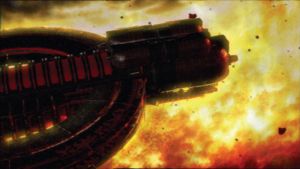
Farscape the series was cancelled in 2003, and ever since then a loyal fan base pushed hard for the series to return in one form or other. In October they got their wish. Farscape the Peacekeeper Wars reunited not only the original cast but many of the visual effects artists from the Series. Producer Andrew Prowse and visual effects supervisor Benita Carey, headed the visual effects team. For Prowse and Carey, the miniseries also offered them the opportunity to finally achieve the kind of closure they believed the series truly deserved. The end of the series was a major cliffhanger, Prowse commented in an interview with VFXworld. We werent prepared when the show was cancelled, so there was an awful lot of story up in the air. We could have done a quick wrap-up, but it was a little bit of defiance to leave it to be continued and see what happened. The film allows us to finally wrap it up in this sort of compressed series.
Two visual effects companies worked on the latest Farscape mini-series Animal Logic and Digital Pictures – both located in Sydney, Australia. While Animal Logic was the lead facility with the majority of the shots, interestingly both companies had also worked on the original TV series. We spoke to members of the visual effects team at Digital Pictures (DP) where Fxguide co-founder Mike Seymour was lead compositor. “I am a huge Sc-fi fan, – Star Trek, Red Dwarf, Stargate .. you name it, I’m into it, so it was great to be asked to be DP’s lead compositor on Farscape – but mainly because a bunch of the guys at Digital Pictures had worked on the first series of Farscape, and they are a completely obessive group of uber geeks having fun – this was just so much fun to work on – the team was just the best guys in the company having a whale of a time” laughs Mike Seymour – who has recently left Digital Pictures to freelance, consult and provide training in Asia Pacific.
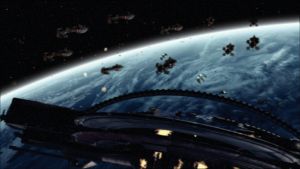
The DP team were tasked with many of the space battles. At one the first meetings, team leader Steve Anderson went to, the VFX director said to animate the fighters like WWII fighter planes. “Brilliant,” comments Dearing , ” So we promptly went out and bought joysticks for all the animators and copies of IL2 (flight simulator)”. The team then spent a week battling every night in the skies over Europe, honing and perfecting their skills as fighter pilots. “These dog fighting skills influenced the way we approached the animation and imparted a sense of realism into our work” points out Dearing. The approach worked and DP was awarded more and more of the final complex space battle, and it quickly came apparent that a more automated system would be required for the larger battle sequences. “Our animators were actually flying fighter craft in real time formation combat and we were capturing data from hundreds of spectacular battles each night. This gave me the idea of using this data like a mini version of massive and I created a particle based intelligent fighter system that let us have thousands of fighters flying in formation, attacking weak targets, avoiding strong ones and of course exploding in a most spectacular fashion when hit” explains team leader Steve Anderson.
In addition for the battle sequences many hours were spent watching DVDs of gun camera action and formation combat tactics from WWII. Re-living this kind of flying in networked simulations was key to the success at animating
fighter craft in a manner that stimulates the viewer with recognition and empathy. “Of course we all know that fighter craft space ships probably should not fly like WWII fighters but recognition of this kind of combat is
a fantastic aide to suspension of disbelief and immerses the viewer into a rich combat experience” comments Anderson. It was the real world reference and game like logic that made the fights work, “and it worked well in other ways – one night at 2 am I need a new 3D element”, explains Seymour, “Steve Anderson came back 5 mins later and said that as most of team were still in the 3D lab “researching” -and he’d have the new element within an hour – and he did!’
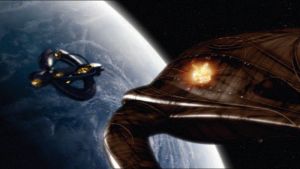
This ‘research’ work built into the huge 1500 ship space battles, a task made more difficult by the massive variation in scale of the various ships. The fighters were very small in comparison to the huge ships they were attacking, and the team found that fighter swarms would quickly become lost if all of the bigger ships were in shot. “We had to quickly establish which smaller ship we were following, by taking it close to camera and then moving it huge distances to attack a bigger ship. It was challenging to make it feel and look right, – It was still fun though, I could happily solve these problems all day.” cheerfully explains Dearing.
The team did not just limit themselves to computer games, Feargal Stewart, one of DP’s lead effects artists was given the task of having the hero space ship “Moya”, raise out of the ocean, – not your typical space ship shot, “Water…! Surface water in Maya is pretty easy to create but as soon as you break the water surface things start to get a bit tricky. The previz included a massive shot of Moya erupting from an ocean. I knew this was going to be one of the most difficult shots to produce”, he comments, “I started looking at as much water reference as google could muster. Loads of images of oil tankers battling huge waves but some of the best reference I could find was a movie of a submarine doing an emergency surface.” The shot ended up being one of the team’s favourites, “The second I saw the board I zeroed on on that shot, – it was the longest shot in the compositing pipeline – mainly because getting scale in water shots is hard anytime, but with CG water it can be really hard.” The solution actually involved filming real surf and using a complex series of hardware particle sprites and layers and layer of 3D spray elements to finally sell the shot.

The pipeline was made more complex by the two facilities sharing both current databases and older libraries from the earlier TV series, one of the biggest challenges was that all the ships had been converted to 3D studio max for the second series, done at Animal Logic, but DP is a Maya facility. DP had to import all the models into Maya, animate them and then export them back to max for rendering, to keep the same look between the two FX houses. Steve Anderson explains “Since our skill base at DP in Sydney is in Maya, we wound up exporting low res proxies of each ship from Max into Maya for animation. Then when the director had signed off on the pre-vis we would simply export the animation for the Max based ships and the camera move and render them whilst rendering any Maya based elements separately. This was a very fast process and it was quite empowering as we were able to exploit the procedural flexibility of Maya for the tricky VFX yet have our shots inter cut seamlessly with those from Animal Logic’s Farscape team who were only using Max.”
DP had planned to do much of the compositing in Shake but moved quite early on into actual production as the number of shots grew, the compositing moved almost entirely to Infenro and Flame. ” The greatest asset that we introduced to our pipeline on this project was BURN”, explains Seymour. ” BURN was a lifesaver. I moved on to night shifts and as many of the shots had hundreds of elements I could set up complex batch trees, have them rendering on BURN while I set up the next shot. For a few nights I was working two suites at once – setting up complex comps and polishing on inferno, and ‘bash comping’ test renders on our Tezro flame – to just see how the basic 3D was looking at that point. With shots taking over 90 mins to render my productivity shot up with BURN – I’d never do another major Discreet project without BURN – it is worth its weight in gold”. DP found that their multiple BURN render farm was delivering effective the power equal to an Onyx 2 in performance – depending upon the shot, the amount of network traffic and sparks used.
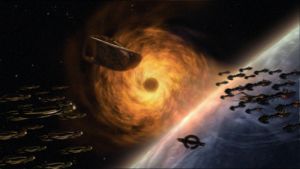
Rather than the traditional approach of treating 2d and 3d departments as separate with a one way flow, the team set up a circular collaboration between the two. This is particularly empowering during design and development of visual effects and lead to a faster turn around and more flexibility in the Inferno suite. This was seen, for example, in the creation of the dooms day wormhole effect that had to go through several growing stages through several shots. Traditionally this would have been a collection of 3d layers rendered specifically for the perspective of each shot. “By rendering our 3d layers as a kit of parts in HD resolution (1920×1080) from a more orthographic view, Mike Seymour was able to create a wormhole treatment that was enhanced with 2d elements before it was put into perspective in the shot – in the inferno.” explains Steve Anderson “This meant that Mike was able to use many more tricks that would otherwise be too difficult or that would require extra 3d layers to implement” This approach also meant that the 3d team was creating far less layers and no shot specific renders so that once the look was settled on it could be re-created in as many shots as required without requiring additional 3d renders.
Another returning member of the original Series One team was DP’s head of long form effects and VFX Producer Rob Nicol. One of the requirements from the producers was for us to provide previs and blocking for the large battle scenes and this was completed using Maya. We had 14 people providing CG work and five compositing and the project ran for approximately 10 weeks from initial previs to final delivery.
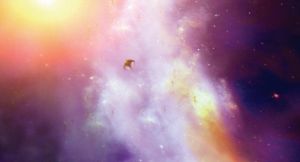
The relationship between the 3d team and the matte painting deartment is very tight at DP. After a shot is pre-visualised in 3d, geometry is created for each element in depth with texture coordinates that the matte painter can easily work with. There are always several versions to and fro but by having the camera move first, the matte painter is never wasting time painting detail that will never be seen. The most complex matte painting to get approved was the final shot of the show, – Moya flying off into the nebula sunset. The camera starts on a closeup of our heros and pulls out from the set piece to revel the 3D Moya spaceship – which then flies off into the distance – in all the shot was 656 frames long. Technically, the shot involved a long 3D track integrating the live action actors into the 3D Moya, – over what was meant to be a simple nemula matte painting. In reality several artist attempted to produce just the right emotional – backdrop, – but none were approved. Furthermore the integrating of the 3D and live action, was extremely challenging. The shot had been filmed with a wide angle lens and quite a bit of movement in the track, additionally the scale of the set, props and objects in the background behind the actors had to fit in with the 3D model of Moya. Jonathen Dearing was tasked with the 3D track integration , “we then had to travel gracefully a huge distance to reveal Moya disappearing into a galaxy. Balancing these things and with a focal lens shift once the 3D camera took over from the original footage behind was tricky.” Once the 3D was finally solved, the lead compositor Mike Seymour actually took over the matte painting, “all previous attempts had failed to be approved – so I ended up painting the final matte painting myself, – and then by using Inferno’s mixed resoloution I mapped the huge matte painting inside a sphere and composited the 3D, and inferno’s camera inside. While technically the dimensions of a sphere are completely wrong for the distances in space – the spherical mapping gave me the wide angle lens distrotion I needed to seamless continue from what the audience had seen at the beginning of the shot into the final tilt and pan of the nebula”.
For all the members of the visual effects team the show finished up well, and for those Like Jonathan Dearing who had just started in the industry at the time of series one, it was particularly rewarding, “it was a great fun project and I was glad to be apart of it, I found a real sense of pleasure having been the render wrangler on the first series and years later working on the very final shot. Nice. ”
Farscape mark & logo, characters and elements are trademarks of The Jim Henson Company. All rights reserved.
